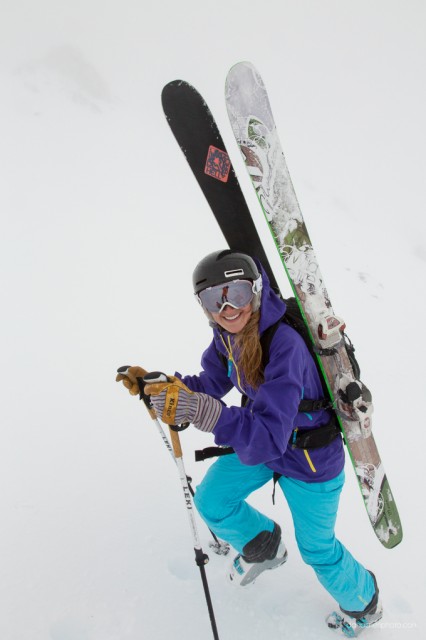Fabric
The Helly Tech Professional line (what I tested), is made from a 3L laminate fabric, while the Helly Tech Performance line is made from a 2.5 layer fabric. Both the Professional and Performance lines have fully sealed seams and DWR treatments.
I mentioned before that the Verglas is made of a thicker, heavier shell material than I’d expected. It feels quite a bit heavier and bulkier than the Scott Explorair jacket, and so it was harder to pack down into my backpack. This wasn’t much of an issue since I was only using my pack for inbounds and hike-to terrain, but if I was on a longer day’s tour with a full pack, I think I’d have trouble fitting the Verglas. I can compress the Explorair down to two-thirds the size of the Verglas, which feels similar in weight and thickness to the Trew Cosmic.
Warmth and Windproofing
Since the Verglas is thicker than the Explorair, I found that it offered a good amount of warmth and wind protection on cold days. While wearing the thinner Explorair, I often doubled up with my Patagonia Micro Puff (in addition to a warm mid or baselayer) for insulation if the temperature was below 30 degrees.
There was only one day that dropped to 20 degrees when I was wearing the Verglas, and I needed to add the Helly Hansen Verglas Down Insulator puffy. While I haven’t taken the Verglas out in sub-zero temps, I imagine that with plenty of warm layers—including down—the jacket will be warm enough. On days above 20 degrees, I was fine with just a thin wool baselayer or a baselayer and technical fleece under the Verglas. I found temperatures above 40-45 degrees were too warm for the Verglas.
The warmth and weight of this jacket does make me less inclined to throw it in my pack as rain protection for summer and fall hikes (something I’ve been doing with the Explorair). However, if I were heading up for a day at the resort or a cold day in the backcountry, I’d be more inclined to grab the Verglas than the Explorair.
Usually when I tour (except on the coldest days) I end up taking off my hard shell jacket anyway, and, given its thickness, I don’t think the Verglas will be any exception. On bootpacks I found the Verglas to be a bit too warm, and I found myself taking it off before the other members of the group ditched their jackets made from either Polartec NeoShell, Gore Tex Pro Shell, or Gore Tex Active Shell.
Breathability
I appreciated the extra long pit vents, but would overheat quickly even on short bootpacks if there wasn’t a breeze. That being said, it is a hard shell, and a thick one at that, and by definition will not be super breathable. The temperatures we were hiking in were also generally pretty warm, ranging from 30 to 45 degrees. However, it is not the most breathable hard shell I’ve worn, which is a tradeoff for its improved warmth.

Waterproofing
I’ve experienced no issues with the Verglas’ waterproofness, and all precipitation beaded off without soaking through. I’ll report back later in the season if I experience any issues with the DWR wearing out.
Durability
Despite my flailing attempts at loading the club field rope tows with a metal nutcracker and repeatedly rubbing the jacket along the abrasive tow, there are no tears in the Verglas and the material looks like new. I’m pleased to report that stains and spills rub off easily, too.
Bottom Line
The Verglas is a tough, well-constructed winter hardshell. Its warmth makes it a good option for any cold weather (below 20 degrees F) inbounds or out-of-bounds skiing.
Its weight and packability are something to keep in mind if you’re looking primarily for a lightweight jacket for long approaches in the backcountry, so I’d recommend it most strongly to those looking for a jacket for resort riding in cold, wet, and windy conditions that will still work well on shorter backcountry tours.
